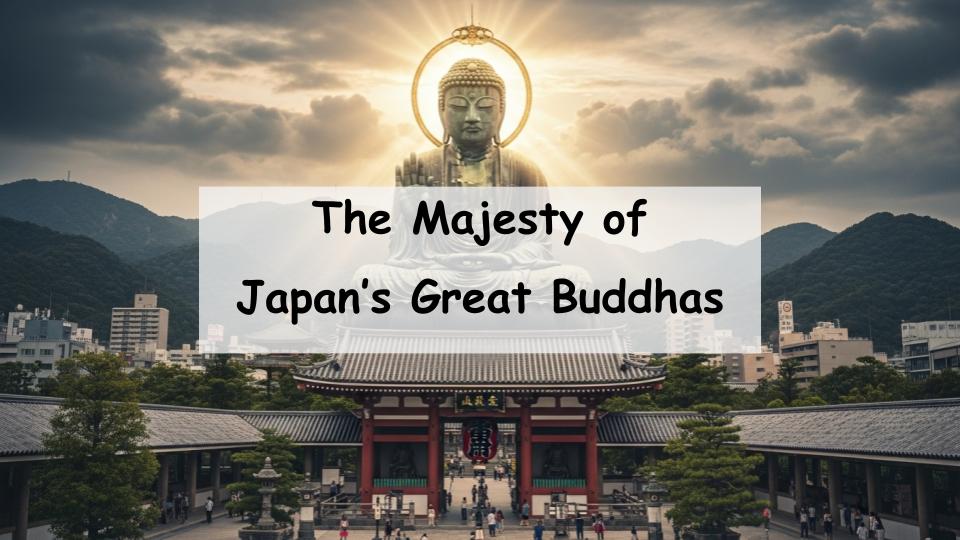“Which statues are considered Japan’s Three Great Buddhas?” “I know about the Great Buddha of Nara, but what are the other two?” — If you’ve ever had these questions, you’re not alone. For travelers and history lovers alike, Japan’s Three Great Buddhas represent must-see cultural landmarks.
In short, “Japan’s Three Great Buddhas” is a popular term used to describe three famous large Buddha statues located in Nara, Kamakura, and Takaoka. However, there are various interpretations depending on local traditions and tourism authorities.
This article will introduce what Japan’s Three Great Buddhas are, delve into the historical background and characteristics of each, and guide you through the highlights and access tips for visiting them. Whether you’re planning a temple tour or want to deepen your understanding of Japanese culture, this is your essential guide.
- What Are Japan’s Three Great Buddhas? Origins and Definitions
- The Charm of the Great Buddha of Nara (Tōdai-ji’s Vairocana Buddha)
- The Charm of the Great Buddha of Kamakura (Kōtoku-in’s Amida Buddha)
- The Charm of the Great Buddha of Takaoka (Daibutsu-ji’s Amida Buddha)
- Other Contenders for Japan’s Three Great Buddhas
- How to Enjoy Visiting Japan’s Three Great Buddhas
- What Japan’s Great Buddhas Reveal About Faith and Culture
- Conclusion
What Are Japan’s Three Great Buddhas? Origins and Definitions
When Did the Term “Three Great Buddhas of Japan” Begin?
The term “Three Great Buddhas of Japan” doesn’t have an official origin but has gradually come into popular use through local promotion and travel culture. It reflects pride in monumental Buddhist statues that have withstood the test of time.
Why These Three Buddhas?
The three most commonly recognized are:
- The Great Buddha of Nara (Tōdai-ji)
- The Great Buddha of Kamakura (Kōtoku-in)
- The Great Buddha of Takaoka (Daibutsu-ji)
They are celebrated for their size, historical significance, and cultural impact.
Are There Other Contenders?
Yes, depending on regional pride or tourism campaigns, other Buddha statues from Kyoto, Gifu, and Hyōgo may be included as alternative “Three Great Buddhas” candidates.
The Charm of the Great Buddha of Nara (Tōdai-ji’s Vairocana Buddha)
History and Background
Constructed in the 8th century during the Nara period, the Great Buddha of Nara is a symbol of national unity and spiritual protection. Commissioned by Emperor Shōmu, it was part of a massive government-led temple project.
Structure and Features
Standing about 15 meters tall, this bronze statue represents Vairocana Buddha (Rushanabutsu). Its intricate craftsmanship and scale continue to awe visitors.
Nearby Attractions
Tōdai-ji is located in Nara Park, home to freely roaming deer and other historic landmarks such as the Great South Gate and Kasuga Taisha Shrine.
The Charm of the Great Buddha of Kamakura (Kōtoku-in’s Amida Buddha)
Historical Background and Legends
Built in the 13th century, this bronze Amida Buddha originally sat inside a temple hall, which was later destroyed by natural disasters, leaving the statue outdoors.
The Power of an Open-Air Buddha
The Kamakura Daibutsu stands about 11.3 meters tall and exudes quiet strength as it sits in the open sky, surrounded by trees and nature.
Exploring Kamakura
Kamakura is full of charming streets, traditional cafés, and temples. It’s a perfect day trip from Tokyo and a great spot to experience Japan’s coastal history.
The Charm of the Great Buddha of Takaoka (Daibutsu-ji’s Amida Buddha)
Founding History and Unique Qualities
Takaoka’s Great Buddha was completed in the 20th century but traces its origin to wooden predecessors dating back to the Edo period. It’s known as one of the most elegant Buddhas in Japan.
Bronze Casting Beauty
Made entirely of cast bronze by local artisans, the Takaoka Daibutsu reflects the region’s long-standing metalworking tradition.
Must-See in Hokuriku
Located in Toyama Prefecture, Takaoka offers a tranquil experience and is a great cultural stop in the Hokuriku area.
Other Contenders for Japan’s Three Great Buddhas
Other Notable Buddhas in Japan
Statues in Kyoto (Rokuharamitsu-ji), Gifu (Shōbō-ji), and Hyōgo (Nōfuku-ji) are sometimes included depending on local pride and significance.
Community Pride in Local Buddhas
Many regions celebrate their own “great Buddha,” symbolizing local history, spiritual identity, and community unity.
How to Enjoy Visiting Japan’s Three Great Buddhas
Efficient Travel Tips
Plan your route efficiently — Nara, Kamakura, and Takaoka are spread across the country. Using rail passes and local guides can make the journey smoother.
Best Seasons to Visit
Spring and autumn offer pleasant weather and beautiful seasonal scenery, enhancing your temple experience.
Enriching Your Visit
Understanding Buddhist iconography, temple etiquette, and regional history will deepen your appreciation of each statue.
What Japan’s Great Buddhas Reveal About Faith and Culture
The Religious and Social Role of Great Buddhas
Beyond their religious function, these statues served as symbols of authority, national unity, and community resilience.
From Worship to Tourism
Today, Japan’s Great Buddhas are cultural assets drawing millions of visitors, bridging past and present.
Conclusion
Japan’s Three Great Buddhas are more than just large statues — they are living monuments to the country’s history, craftsmanship, and spiritual depth. Whether you’re an art lover, history buff, or cultural explorer, visiting these icons offers an unforgettable journey through Japan’s sacred heritage.











Comment